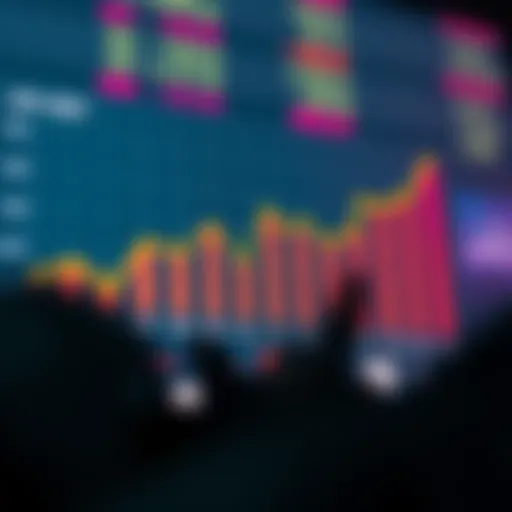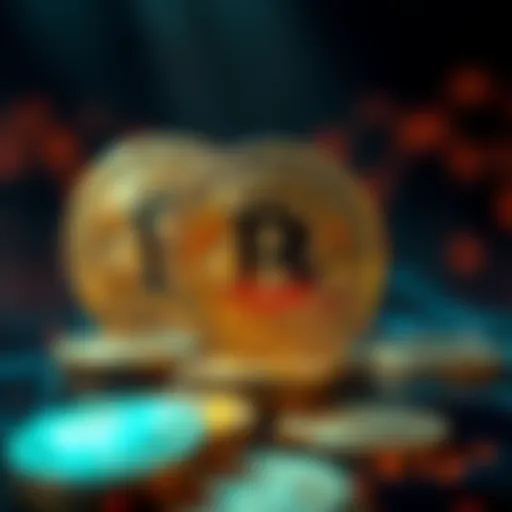Exploring the Intricacies of US Dollar Coins
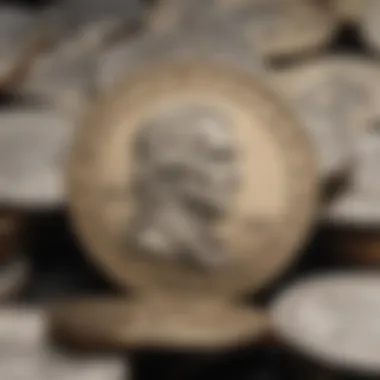

Intro
When it comes to currency in the United States, coins often seem like an afterthought. While paper money dominates our wallets and bank accounts, US dollar coins have a rich yet underappreciated history. They embody tales of economic shifts, technological advances, and an ongoing debate about practicality versus tradition. This article endeavors to peel back the layers surrounding these coins, illuminating their historical significance while laying bare their relevance in today’s marketplace.
As we delve into the value of US dollar coins, we will explore not just their monetary worth, but also the factors contributing to their investment potential. The past few decades have seen a renewed interest in these coins among collectors and investors alike, spurred by their unique designs and the stories they tell.
So, what prompts this intrigue? Is it the allure of owning a piece of history or the prospect of financial gain? We'll take a closer look, addressing both practical concerns and the aesthetic enjoyment that these coins provide. In doing so, we intend to offer a comprehensive understanding of the value of US dollar coins, from historical context and minting processes to current market trends and investment strategies.
Intro to US Dollar Coins
The world of currency is more diverse than what many people may realize. Among the different forms of money, US dollar coins hold a unique position. In this article, we will delve into the significance of these coins, highlighting their historical roots and marvelous journey throughout American financial history. It’s essential to understand the foundations of these coins, as they reflect both cultural storytelling and economic fluctuations. By examining their trajectory, collectors and investors can gain insights that offer greater appreciation and opportunitues regarding dollar coins today.
Historical Context
Looking back, the story of US dollar coins began in a landscape where coinage was strictly tied to precious metals. The introduction of the first dollar coin in 1794 was a catalyst that marked the shift from barter systems to a more structured means of trade. Many will recognize the famous Morgan dollar, a coin that captures the essence of an era shaped by trade wars and economic booms.
In addition, the minting of the Eisenhower dollar in the mid-20th century was a direct response to both commemorative motivations and the demands for circulating currency. As time rolled on, the introduction of the modern Native American and Presidential dollar coins in the 21st century showcased an effort to revive the use of coins while reflecting the nation's rich cultural heritage. Each coin tells a story of its own while simultaneously documenting a critical time in American history.
Purpose of Minting Dollar Coins
Dollar coins were not created just for the fun of it; they served a practical purpose too. The initial goal was to replace banknotes for large transactions, a mission that stemmed from the need for a more durable and cost-effective currency. Dollar coins last significantly longer than paper money—up to 30 years compared to just 18 months for bills. This longevity translates into savings for the government and taxpayers.
Moreover, the minting of coins allows for cultural representation. Each design reflects historical figures and events, promoting civic education and pride. The cultural significance provides layers of value that extend beyond material worth. Therefore, understanding the purpose of minting these coins aligns with broader discussions about national identity, trade, and financial strategy in the U.S.
Essentially, the minting of US dollar coins embodies economic innovation, historical commemoration, and an intricate part of America’s numismatic narrative.
As we peal back the layers of what these coins represent, we uncover not just a method of payment but a living archive of the values and priorities that have shaped the nation.
Types of US Dollar Coins
Understanding the types of US dollar coins is vital as each offers unique historical, cultural, and economic significance. This section will detail the various dollar coins, providing insights into their origins, features, and collectors’ appeal. Awareness of these types can greatly inform investors and individuals considering starting a collection. Each coin type showcases different aspects of American history and values, allowing collectors and investors to find something that resonates personally and financially.
Native American One Dollar Coin
The Native American One Dollar Coin honors the rich cultures and contributions of Native Americans. First released in 2000, these coins feature a striking image of Sacagawea, the Shoshone woman who played a crucial role in the Lewis and Clark expedition. Each year, the reverse side of the coin showcases various Native American themes and designs, which changes annually, bringing fresh appeal to collectors.
Collectors and investors often place a premium on these coins due to their limited mintage and the cultural heritage they represent. Assembling a complete set not only serves as an investment but also as a celebration of diversity and history. Moreover, their gold-colored finish makes them visually distinct among dollar coins, attracting both numismatists and casual collectors alike.
Presidential One Dollar Coin
The Presidential One Dollar Coin series has been a staple for collectors since it began in 2007. Each coin in this series features the image of a U.S. president, the first being George Washington. The series aims to celebrate the legacy of each leader while increasing public awareness of American history.
One distinguishing characteristic of these coins is their edge lettering, which includes the date of minting and the motto "E Pluribus Unum." Investors may see potential in these coins as they feature all deceased presidents, thus providing a finite collection opportunity. However, interest can vary from year to year depending on the popularity of the featured presidents, making awareness of market trends crucial for potential investors.
Eisenhower Dollar
Introduced in 1971, the Eisenhower Dollar commemorates President Dwight D. Eisenhower and is notable for its large size, which is the largest U.S. dollar coin made for circulation. The coin showcases a design that includes a profile of Eisenhower on the obverse and an eagle landing on the moon on the reverse, symbolizing the Apollo 11 mission—a crucial moment in American history.
While Eisenhower Dollars were produced for circulation, certain issues are sought after by collectors due to their limited numbers and specific mint marks. It's worth noting that the collectors' market has a varried demand for these coins; some collectors view them as pristine pieces for potential future appreciation. These factors can significantly affect their value over time.
Morgan and Peace Dollars
Morgan and Peace Dollars are iconic in the world of coin collecting. Struck between 1878 and 1904 and then again in 1921, the Morgan Dollar became a symbol of American prosperity. Featuring a lady on the obverse and an eagle on the reverse, these coins reflect the artistry and craftsmanship of their time.
The Peace Dollar, which came immediately after the Morgan, was first minted in 1921 and symbolizes the end of World War I. Its smooth lines and peaceful imagery capture the hope of a nation. Both coins attract high investor interest, partly due to their precious metal content and historical significance.
Their rarity, condition, and demand in the collector’s market can lead to substantial variations in value. For investors and collectors, staying informed about current market trends and potential for future appreciation is essential in navigating the trade of such heritage coins.
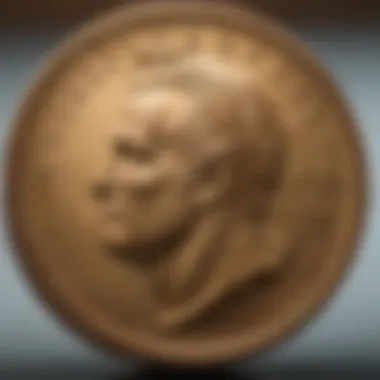

Minting and Production
The minting and production of US dollar coins play a crucial role in understanding their value, both for numismatists and everyday consumers. These processes not only affect the physical attributes of the coins but also their availability and desirability in the market. A thorough grasp of how these coins are created and circulated can illuminate the intricacies of their valuation and appeal.
Minting Process Overview
The minting process for US dollar coins is quite an elaborate endeavor, designed to ensure that each coin meets stringent standards of quality and durability. Initially, the design phase is paramount. Skilled artists collaborate to create designs that reflect cultural and historical significance, blending craftsmanship with symbolism.
After designs are approved, the production begins at one of the U.S. Mint's facilities, such as those located in Philadelphia, Denver, San Francisco, and West Point. The production goes through several key steps:
- Blanking: Thin strips of metal are cut into circular blanks.
- Annealing: These blanks are heated to make them softer and more workable.
- Upsetting: Each blank is then raised on its edges, creating a rim to help the coin retain its shape during striking.
- Striking: Finally, the coins are struck with high-pressure dies, which imprint the images and inscriptions on both sides of the coin.
During this process, several forms of quality assurance are conducted. The minute details of everything from weight to centering are checked; precision is key. This is an important step, as deviations can lead to significant declines in a coin's value in collectors' circles.
Circulating vs. Non-Circulating Coins
Understanding the distinction between circulating and non-circulating coins offers insight into their respective values. Circulating coins are designed for everyday transactions. They often appear in numerous circulation types and must be manufactured in large quantities to meet public demand. These coins tend to have a lower value for collectors than their non-circulating counterparts, simply because they are more readily available.
Conversely, non-circulating coins, often created for collectors or commemorative purposes, represent a unique blend of artistry and scarcity. They may come in limited runs or special editions, making them more desirable among enthusiasts. Their value can appreciate considerably over time, given the right market conditions and collector interest.
"The allure of non-circulating coins often lies in their rarity and the story they tell, capturing moments in history while allowing collectors to hold a piece of that story in their hands."
Factors Affecting Value
When diving into the world of US dollar coins, understanding the factors that affect their value is vital. The market for these coins isn't just about shiny metal or nostalgia; it weaves together rarity, condition, and ever-evolving trends. Let’s unpack these elements, as they each hold significant weight in determining just how much a piece of change might be worth.
Rarity and Demand
Rarity is a powerhouse player in the value game. A coin isn't just considered rare because it’s old, but rather due to its limited minting numbers and historical significance. For instance, certain editions of the Morgan Dollar and Peace Dollar are often sought after because only a handful exist today.
The demand for these pieces can fluctuate wildly. Suppose a coin is identified as one of only a few in existence, it might trigger a bidding war at auctions, shooting the price through the roof. This interplay shows how rarity and demand dance together. For collectors and investors alike, it’s like striking gold when they find an undervalued piece of history in their possession.
"The value of a coin often lies in the eyes of the beholder, shaped by its scarcity and the desire it invokes."
Condition and Grading
When it comes to coins, condition is king. You could have a rare coin, but if it’s battered and worn, its value can plummet like a lead balloon. Coins are graded on their quality, which is usually done on a scale from Poor to Perfect Mint State.
Investors need to familiarize themselves with grading systems. The Sheldon Scale, for example, is widely used; it ranges from 1 to 70, with 70 representing an immaculate example. The finer the condition, the more likely the coin will fetch a handsome price at auction.
The Numismatic Guaranty Corporation and Professional Coin Grading Service are trusted organizations that provide these essential grading services. Coins in mint condition can command prices that are multiples of their face value, making condition a major factor in the overall worth.
Market Trends
Market trends are the winds that can change the entire landscape of coin value. They can shift for various reasons, including economic climates, collector interest, and technological advancements in coin valuation, such as the rise of digital platforms for trading.
Keeping an eye on these trends is crucial. For example, during periods of economic uncertainty, tangible assets like coins may see an uptick in value. On the other hand, a surge in digital currency interest might lead to a dip in coin collecting popularity.
Investors must actively monitor market conditions and publications, like those from the American Numismatic Association or online forums such as reddit.com, where enthusiasts share insights and trends. Being aware of these trends can help investors make informed decisions about when to buy or sell.
As you navigate this detailed landscape, it becomes clear that the value of US dollar coins is influenced by a tapestry of factors, each as crucial as the next. Their worth is a careful blend of rarity, condition, and the pulse of market conditions, all adding depth to their significance in the numismatic realm.
Current Market Trends
In the realm of numismatics, understanding the current market trends is crucial for enthusiasts and investors alike. The shifts in demand, pricing fluctuations, and collector behavior can provide significant clues about the future potential of US dollar coins. Particularly, keeping track of recent sales data and gauging investor interest serves as solid ground for making informed choices. As a matter of fact, staying ahead of the curve can be the difference between a wise investment and a regrettable miss.
Recent Sales Data
Sales data, when analyzed correctly, offers a window into the health of the dollar coin market. Over the past few years, different types of dollar coins have shown varying degrees of popularity and price movement. For example, while the Native American One Dollar Coin keenly draws collectors' interests due to its rich cultural heritage, the Presidential One Dollar Coin finds itself somewhat dormant in terms of price appreciation.
To illustrate, a recent auction of Morgan and Peace dollars revealed that pristine examples sold for not just multiples of their face value but could fetch thousands, depending on condition.
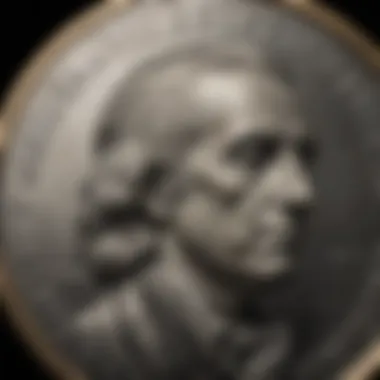

- Key indicators of sales trends:
- Total Volume: How many coins were sold in a particular period?
- Average Price: What are the average selling prices of different types?
- High and Low Sales: This helps identify outliers or exceptionally rare coins that may command a premium.
Another significant aspect is how the sales trends for specific dollar coins can reflect broader economic conditions. If the economy is sluggish, coin collecting may be perceived as a luxury, and sales may dip. Conversely, in a booming economy, more investment may flow into collectibles as people seek alternative assets.
Investor Interest
Investor interest in US dollar coins varies widely. Individuals may consider a host of factors before diving into the market, including resale potential, historical significance, and rarity. For most investors, diversifying their portfolios with tangible assets like coins can result in lucrative returns over time, especially if the coins appreciate in value.
- Main areas of investor concern:
- Long-Term Viability: Are these coins likely to retain or increase their value?
- Market Sentiment: How do collectors view the charm and worth of dollar coins?
- Investment Grade Coins: Not all coins are created equal; understanding which coins to consider is vital.
With a growing trend towards sustainability and tangible investments, dollar coins have recently seen a surge in interest. Many investors consider them as a hedge against inflation, driving up demand in uncertain economic times. The engagement in online platforms and communities, such as those on Reddit, fuels conversations and creates buzz around certain coins which can amplify interest and ultimately the value.
"The market is like the tide: it ebbs and flows, and understanding the currents can lead to safe harbor."
Put simply, while investing in US dollar coins involves risks, keeping a keen eye on market trends and understanding real-time sales data can empower investors to make strategic decisions. As market dynamics continue to change, having your finger on the pulse of what's happening with these coins is more essential than ever.
Comparison with Other Currency Forms
When we dive into the world of US dollar coins, it's inevitable to compare them with other forms of currency. This comparison is not merely academic; it presents significant implications for collectors and investors. Understanding how dollar coins stack up against paper currency and digital money helps form a more complete picture of their value in current markets.
Fiat Currency vs. Coin Collecting
Fiat currency, such as paper dollars, is basically money that governments declare as legal tender, but it has no intrinsic value of its own. It’s backed by trust, rather than a physical commodity. This is where dollar coins come into play. While many folks casually spend paper bills without a second thought, coins can carry a much deeper narrative, especially among enthusiasts.
- Value Retention: Unlike fiat currency, which depreciates due to inflation, certain dollar coins have shown potential for long-term value retention. Take the Eisenhower Dollar, for instance. Although produced in mass quantities, particular versions have become sought after by collectors, potentially appreciating in value.
- Collectible Nature: Collectors often see dollar coins as more than just currency; they represent history, craftsmanship, and artistry. While fiat currency is generally seen as utilitarian, coins can be appreciated and valued based on rarity and condition. The Morgan Dollar, for example, appeals not only as legal tender but as a collectible object of art.
- Liquidity and Accessibility: Dollar coins can be less liquid than paper money. In some cases, merchants may not be as willing to accept coins, reducing their practical usability. However, this doesn't take away from their appeal as a collectible or investment vehicle especially for those who appreciate the tangible aspects of numismatics.
Digital Currency's Impact on Coins
As we shift gears, what really becomes interesting is the emergence of digital currency. Bitcoin, Ethereum, and other cryptocurrencies are making waves in financial systems, and they bring a host of considerations for traditional coinage.
- Market Shift: The rise of digital currency is reshaping the way people view tangible money. Collectors might wonder if dollar coins will eventually wane in importance as transactions become increasingly digital. After all, physical coins seem to be less and less necessary in a cashless society.
- Investment Trends: Some investors are pivoting their focus to digital investments, perhaps neglecting the rich tapestry of numismatics. However, the age-old principle of diversification suggests that dollar coins could complement a modern investment strategy involving cryptocurrencies.
- Appeal of Tangibility: For many, the tactile nature of coins—holding a piece of history—offers an experience that digital currencies cannot replicate. Even in an age dominated by technology, there's something to be said for the feeling of a coin in hand, representing stability amidst constant financial evolution.
The dynamic interaction between different forms of currency highlights not just market trends, but also shifts in investor psychology and societal values.
Investment Potential
The investment potential of US dollar coins is often a topic of intrigue for collectors, investors, and casual enthusiasts alike. As tangible assets, these coins carry both historical significance and monetary value, which can fluctuate based on various factors. Understanding their potential as investment vehicles is crucial for anyone looking to delve into the realm of numismatics.
Long-Term vs. Short-Term Gains
When discussing dollar coins as an investment, one must consider the long-term and short-term gain perspectives.
Long-term investment in dollar coins often appeals to those who are patient and willing to endure market fluctuations. Collectors see value increase over decades—sometimes due to rarity, historical significance, or shifts in collector interest. For example, a rare Eisenhower dollar, which isn’t commonly used today, can appreciate significantly as time goes on, especially if the coin is kept in good condition.
Conversely, short-term investors might capitalize on market trends or speculative buys. Such investors often rely on immediate demand spikes following newsworthy events, such as a coin's relaunch or publicity related to the pioneer figures represented on certain coins. Short-term strategies can lead to quick profits but also come with higher risks; thus, one must tread carefully.
Diversifying with Dollar Coins
Using dollar coins as part of an investment strategy can also serve to diversify a portfolio. The numismatic market has distinct behaviors compared to stocks or bonds, providing potential insulation against traditional market volatilities. Investors might choose to allocate a small percentage of their investment budget to dollar coins to balance their portfolio.
Some key benefits of including dollar coins in your investment strategy include:
- Stability: Coins are physical assets that tend to hold intrinsic value regardless of broader market conditions.
- Passion: Collecting oftentimes combines investment with a hobby—there’s joy in owning a piece of history.
- Accessibility: A wide range of dollar coins exist at different price points, making them accessible to various levels of investors.
However, it’s important to be mindful of possible downsides such as fluctuating demand, condition sensitivity, and market saturation.
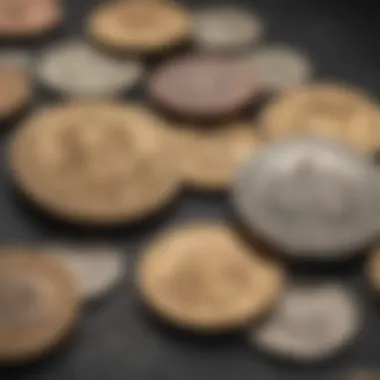

"Diversity in investment is like a safety net; it cushions against unforeseen falls."
Numerous resources, such as Wikipedia and forums like Reddit, can provide more insights into market trends and tips for collectors. As investors navigate the world of collectibles, understanding both the historical context and the current marketplace dynamics will augment their strategy for success.
Collecting Dollar Coins
Collecting US dollar coins presents a unique blend of historical significance and potential investment value. This isn’t merely a hobby; it's a tangible way to connect with the country's past while also engaging with a market that can fluctuate much like any other investment avenue. Understanding the nuances of collecting dollar coins is crucial for anyone considering this as a pursuit.
Starting a Collection
Getting started with a coin collection isn't as simple as diving into a local store and grabbing what's available. It requires some thought and planning. Here are some points to consider:
- Define Your Focus: Are you interested in a specific type, like the Native American One Dollar Coin or the Presidential series? Or are you looking for a broader range of US dollar coins? Knowing your focus will help you in curating a meaningful collection.
- Set a Budget: Just like any investment, it's wise to set a budget. Dollar coins can vary greatly in price depending on their rarity and condition.
- Research: Before making any purchase, do a bit of homework. Understand the history behind each coin type and find out which pieces are considered valuable or desirable among collectors. Websites like Wikipedia provide a wealth of information on various coin types and their historical context.
- Join a Community: Engaging with fellow enthusiasts can provide invaluable insights. Forums on Reddit or local collector groups can be great places to learn, share, and sometimes find trading opportunities.
- Start Small: It’s easy to get overwhelmed with the vast number of choices available. Begin with a few coins that resonate with you, and gradually expand your collection as you learn more.
Preservation Techniques
Once you've started your collection, the next crucial element is preserving it for the long haul. Proper care can help maintain a coin’s condition, which directly affects its value. Here are some preservation techniques worth considering:
- Use Proper Storage: Invest in coin holders, flips, or albums specifically designed for coin storage. Avoid using tape or plastic that might scratch the coins. It's better to utilize Mylar or PVC-free options to keep coins secure yet visible.
- Handle with Care: Always handle dollar coins by the edges and avoid touching the surfaces with bare hands. The oils and dirt from your fingers can leave marks or cause tarnishing over time.
- Avoid Cleaning: This might sound counterintuitive, but cleaning a coin can significantly diminish its value. If a coin is dirty, it's usually best to seek professional advice instead of trying to clean it yourself.
- Maintain a Controlled Environment: Store your collection in a space that is not too humid or dry. A controlled environment can prevent oxidation and other damaging effects.
“A well-preserved coin is a testament to history and a potential goldmine for collectors.”
Future Outlook
The landscape of U.S. dollar coins is evolving, and understanding this future outlook is essential for collectors, investors, and even casual observers. As the economy fluctuates and new technologies emerge, the value and relevance of dollar coins are being reshaped. Moreover, this section aims to provide insight into not just where the market stands today, but where it is headed, thus informing the decisions of those involved in numismatics.
A keen awareness of future trends can enable investors to capitalize on potential opportunities. Likewise, collectors can refine their approaches to building their collections by aligning with emerging market trends. Several factors will shape the trajectory of the dollar coin market, including changes in legislation, shifts in circulation patterns, and advancements in digitization.
"In the world of collecting and investment, timing can be everything. It's essential to keep an eye on future trends that could affect the value of your assets."
Predictions for the Dollar Coin Market
While it is impossible to predict the future with absolute certainty, several indicators can hint at the direction of the dollar coin market. As we look ahead, three significant predictions emerge:
- Increased Market Interest: Many experts anticipate a growing interest in dollar coins, particularly among millennials and younger generations who might find traditional currency less appealing. This demographic shift could lead to a surge in demand for both collectible coins and everyday circulation coins.
- Legislation Changes: The legal landscape surrounding currency production might see new proposals aimed at enhancing the usage of dollar coins. For example, if legislation were to encourage the use of coins over paper bills, we might see increased minting of dollar coins, further supporting their value.
- Sustained Value for Rare Coins: As awareness of numismatics continues to grow, the intriguing concept of rarity will maintain its value. Coins that are hard to find or have historical significance are likely to appreciate. New collectors jumping into the scene could fuel further competition in the market.
These predictions imply there is strong potential for dollar coins to regain prominence, making now an interesting time to monitor developments in this space.
The Role of Technology in Coin Valuation
Technology is a game changer in nearly every sector, and the world of coin collecting and investment is no exception. The role of technology in coin valuation is predicted to expand significantly in the coming years. Here’s how:
- Digital Grading Algorithms: Advanced algorithms may soon provide a more objective way to assess coin condition. Unlike traditional grading methods, which can vary between graders, these digital tools could standardize assessments, enhancing buyer confidence and potentially stabilizing prices.
- Blockchain for Provenance: Tracking the history of a coin through blockchain technology could revolutionize how collectors verify authenticity and provenance. This enhanced traceability may lead to higher trust and value in the market.
- Online Marketplaces and Auctions: E-commerce platforms that focus on rare coins make it easier for people worldwide to buy and sell. This increased accessibility could lead to higher transaction volumes and more lively market activity. As buyers expand their search horizons, prices may adjust more dynamically.
Enhancements brought by technology signal a shift not only in how valuations are made but also in how transactions occur, impacting the overall health of the dollar coin market.
In summary, the future outlook for U.S. dollar coins is lined with potential shifts driven by both consumer behavior and technological advancements. Keeping abreast of these trends will be key for anyone involved in the numismatic community.
The End
The conclusion serves as a pivotal element in any article, enveloping the dense topics discussed and crystallizing insights into an easily digestible format. In the context of understanding US dollar coins, it is essential because it allows readers to reflect on the key takeaways while highlighting the intrinsic value these coins hold.
When examining the subject from multiple angles—historical significance, investment potential, and market trends—the conclusion not only encapsulates the essence of the arguments made but also prepares the reader for future engagement with the topic. In a world where digital currency is on the rise, the tangible nature of dollar coins presents a unique appeal that should not be overlooked. The transition back to basics can be refreshing for investors, making it clear that there’s still a place for physical currency in investment strategies.
Continuing to dive into the significance of dollar coins reveals not just a collector's passion but also reflects the ongoing changes in financial landscapes. This necessitates a broader consideration of how the value of these coins may shift over time due to factors like rarity, demand among collectors, and even technological advancements that aid in valuation.
Summary of Key Points
- Historical Context: Dollar coins have a rich history that offers insight into their value today.
- Rarity and Demand: The availability of certain coins can dramatically affect their market price.
- Investment Potential: Understanding both short- and long-term strategies can benefit coin collectors and investors alike.
- Market Trends: Awareness of current trends helps in making informed decisions about buying or selling these coins.
- Future Outlook: Keeping an eye on predictions concerning dollar coins ensures preparedness as the market evolves.
Final Thoughts on Dollar Coin Value
Ultimately, the value of US dollar coins transcends mere numbers. They represent history, economic shifts, and cultural touchstones that contribute to their appeal. Investors and collectors alike are encouraged to appreciate not just the coin's face value but also the narratives that contribute to their rarity and desirability.
In considering dollar coins as an investment option, it becomes clear that understanding the various dimensions of their worth can provide an edge in this unique market. As the financial landscape continues to evolve, embracing both physical coins and an awareness of trends can play a significant role in developing a robust investment portfolio. In an age where digital transactions increasingly dominate, the enduring fascination with physical currency like dollar coins remains a compelling part of the financial tapestry.





